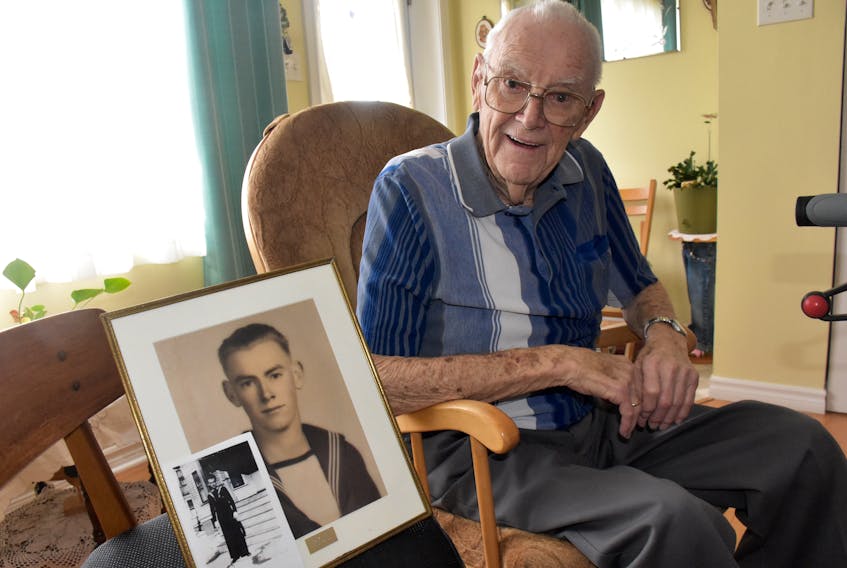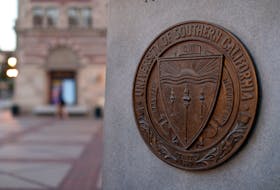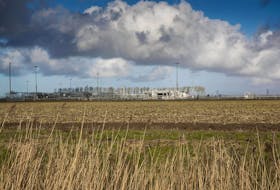YARMOUTH, N.S. — There are photos in the house of a younger version of Wesley Spinney.
When he was 18. He’s 95 now.
His hair is now grey. His face weathered by age. His hands tremble. And when he thinks back to the Second World War, at times his voice cracks and his tears flow.
Because when he shares his memories in his Yarmouth home, he’s still that young man you see in those photos. The young man who enlisted because that’s what everyone else was doing. The young man who wondered countless times, ‘Am I going to survive?’

“We was bombed. We was rammed. We was shelled. We had everything fired at us but the galley sink,” he says, thinking back to his time as a Quartermaster in the navy. Spinney served on the HMCS Kamloops, a corvette that served as a convoy escort ship, and the Qu’Appelle, a destroyer in the Royal Canadian Navy that fought the enemy and escorted soldiers and supplies in the English Channel off Normandy on D-Day on June 6, 1944, and during subsequent weeks.
“There were four of us,” he says about the ships he was on or near whose job it was to keep the allies forces safe. “That’s where we were on D-Day, we were in the channel, in the north end. Each one in its own zone. They had to keep things clear so the submarines couldn’t get through to our allied forces.”

Although much time has passed, certain things will trigger good and bad memories. The good memories are being together with your friends on the ship. “It’s just like a family,” he says.
The bad memories range from the times they sailed up north and the ships would ice up so thick they were barely recognizable – “The elements, sometimes, was worse than the enemy,” he says – to the battles and the injuries and the deaths and the close calls that were all frightening.
“On the escort you weren’t always trying to sink the submarines. You were trying to get that convoy through. The point wasn’t to sink ‘em, the point was to steer clear of them if you could and get that convoy across the Atlantic with its supplies.”
YOU'RE THINKING, 'AM I GOING TO COME OUT ALIVE?'
There were hard nights and hard days when you would pick up the enemy on the radars – if you were lucky. Sometimes you didn’t know where the enemy was.
“You’re scared. You know the enemy is coming towards you. You’re thinking, ‘Am I going to come out alive?’” he says, his voice breaking with emotion more than seven decades later. “But when you’re in the situation you’re a gunner and your mind is on that gun.” Even as you saw bullets whizzing past, he says, you had a job to do.
“Once you get in there you’re not going to desert your friends and buddies. They’re like your family. And when you’re on a ship there’s no place you can run anyhow,” he says. “You can’t dig a foxhole to hide in.”

It was hard to see your friends bleeding on the ship’s deck, he says. And it was no easier when you had to pluck casualties out of the water after ships sank.
“Other times you couldn’t stop and pick them up when you were fighting. You had to steam through them and you could hear them hollering,” he says, crying. “You’d send a ship back to pick up casualties. We picked up the Germans as well as the Canadians. The enemy would be mixed in amongst us and they were just the same as we were – just young kids.”

A DIFFERENT EXPERIENCE
For Yarmouth County resident Alcide LeBlanc, now 99 years old, when he returned from the war he worked hard to leave the memories behind – literally.

“I arrived home and three days later I was the sole owner of a small hotel in Wedgeport and that gave me the chance to train my mind all on the hotel and the business to come,” he says. For 47 years he ran hotels – the Wedgeport Inn, The Anchor Inn in Meteghan and another small motel in Yarmouth.
It helped to occupy his mind and leave the war memories behind.
LeBlanc was a canon gunner in the 4th Field Regiment of the 2th Division in the Canadian Army. He was also a batman to a captain who decided where the canons should be aimed against the enemy. And as the driver of the captain’s jeep LeBlanc would get as close to the enemy lines as they could. He fought against the Germans for over nine months from Normandy to near Berlin.
“I was overseas on D-Day, but I was not at the frontline,” he says. “I was there exactly one month after D-Day.”
He landed on the shores of Normandy where an assignment was to bury dead Canadian soldiers in shallow graves. As he did he’d think about their parents back home, not knowing where their sons were at this moment.
After returning home from the war, eventually he and four others were instrumental in starting up the Royal Canadian Legion Branch 155 in Wedgeport. He’s the only one still alive of those five.
“It was a big Legion branch that was successful, and it’s still successful,” he says.
SPECIAL CEREMONY AT WEDGEPORT LEGION
At a special ceremony on June 6, the Wedgeport Legion will commemorate 75th anniversary of D-Day. The ceremony will take place at the legion hall at 10:45 a.m. followed at 11:30 a.m. by a reception. Legion members and the public are invited to attend. The Government of France will be represented at our ceremony with the attendance of Robert-Yves Mazerolle, the honorary consul of France in Halifax.
In 2014, both Spinney and LeBlanc were among those from the Wedgeport Legion awarded the rank of Knight of the French National Order of the Legion of Honour in recognition of their involvement in the liberation of France during World War II.
Spinney says it is important to him that people never forget the sacrifices that were made during past wars. His wish would be for a world where wars no longer exist.
LeBlanc, who turns 100 next March, shares those sentiments, but he doesn’t think back his own war experience as much as Spinney does.
“I feel as a young man I did my duty and I didn’t end up in trouble,” he says. “I was lucky enough to return back home and thank the Lord that he’s still keeping me alive.”


ABOUT D-DAY
During World War II (1939-1945), the Battle of Normandy, France, which lasted from June 1944 to August 1944, resulted in the Allied liberation of Western Europe from Nazi Germany’s control. Codenamed Operation Overlord, the battle began on June 6, 1944, also known as D-Day, when some 156,000 American, British and Canadian forces landed on five beaches along a 50-mile stretch of the heavily fortified coast of France’s Normandy region.
This year marks the 75th anniversary.
D-DAY AT 75: Remembering the heroes and sacrifices of Atlantic Canada:
- VIDEO: The road to D-Day
- Why a school in France is named for a Pictou soldier
- U-boat hunter Roderick Deon returns to Juno Beach for D-Day
- Sound of gunfire rang in P.E.I. soldier’s ears
- North Nova Scotia Highlanders at the sharp end of D-Day invasion
- STORY MAP: Follow the D-Day experience of the North Nova Scotia Highlanders
- 12 North Nova Scotia Highlanders murdered at Abbaye d’Ardenne
- ‘It was noisy as the devil,’ says St. John’s torpedo man
- 59th Newfoundland Heavy Regiment was eager to do its part
- A P.E.I. dispatcher’s long, uncertain journey to Normandy
- LAURENT LE PIERRÈS: D-Day invasion was best birthday present for my Dad
- ‘Sight of our boys being blown up ... wouldn’t leave my mind:’ Bedford veteran, author
- Dartmouth veteran's first combat mission was D-Day invasion
- Halifax air gunner had bird’s-eye view of D-Day
- ‘We had everything fired at us but the galley sink’: Yarmouth County veterans share war and D-Day memories
- New Waterford veteran has lived good life after surviving D-Day invasion
- JOHN DeMONT: An old film clip of D-Day shows the nature of courage
- D-Day landing map’s origins a mystery to army museum historians









